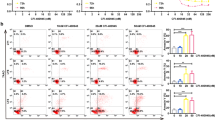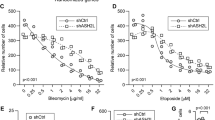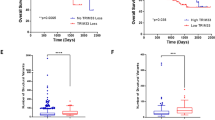Abstract
Most of the anaplastic large-cell lymphoma (ALCL) cases carry the t(2;5; p23;q35) that produces the fusion protein NPM-ALK (nucleophosmin-anaplastic lymphoma kinase). NPM-ALK-deregulated kinase activity drives several pathways that support malignant transformation of lymphoma cells. We found that in ALK-rearranged ALCL cell lines, NPM-ALK was distributed in equal amounts between the cytoplasm and the nucleus. Only the cytoplasmic portion was catalytically active in both cell lines and primary ALCL, whereas the nuclear portion was inactive because of heterodimerization with NPM1. Thus, about 50% of the NPM-ALK is not active and sequestered as NPM-ALK/NPM1 heterodimers in the nucleus. Overexpression or relocalization of NPM-ALK to the cytoplasm by NPM genetic knockout or knockdown caused ERK1/2 (extracellular signal-regulated protein kinases 1 and 2) increased phosphorylation and cell death through the engagement of an ATM/Chk2- and γH2AX (phosphorylated H2A histone family member X)-mediated DNA-damage response. Remarkably, human NPM-ALK-amplified cell lines resistant to ALK tyrosine kinase inhibitors (TKIs) underwent apoptosis upon drug withdrawal as a consequence of ERK1/2 hyperactivation. Altogether, these findings indicate that an excess of NPM-ALK activation and signaling induces apoptosis via oncogenic stress responses. A ‘drug holiday’ where the ALK TKI treatment is suspended could represent a therapeutic option in cells that become resistant by NPM-ALK amplification.
This is a preview of subscription content, access via your institution
Access options
Subscribe to this journal
Receive 50 print issues and online access
$259.00 per year
only $5.18 per issue
Buy this article
- Purchase on Springer Link
- Instant access to full article PDF
Prices may be subject to local taxes which are calculated during checkout








Similar content being viewed by others
References
Chiarle R, Voena C, Ambrogio C, Piva R, Inghirami G . The anaplastic lymphoma kinase in the pathogenesis of cancer. Nat Rev Cancer 2008; 8: 11–23.
Hallberg B, Palmer RH . Mechanistic insight into ALK receptor tyrosine kinase in human cancer biology. Nat Rev Cancer 2013; 13: 685–700.
Morris SW, Kirstein MN, Valentine MB, Dittmer KG, Shapiro DN, Saltman DL et al. Fusion of a kinase gene, ALK, to a nucleolar protein gene, NPM, in non-Hodgkin's lymphoma. Science 1994; 263: 1281–1284.
Pulford K, Morris SW, Turturro F . Anaplastic lymphoma kinase proteins in growth control and cancer. J Cell Physiol 2004; 199: 330–358.
Bischof D, Pulford K, Mason DY, Morris SW . Role of the nucleophosmin (NPM) portion of the non-Hodgkin's lymphoma-associated NPM-anaplastic lymphoma kinase fusion protein in oncogenesis. Mol Cell Biol 1997; 17: 2312–2325.
Mason DY, Pulford KA, Bischof D, Kuefer MU, Butler LH, Lamant L et al. Nucleolar localization of the nucleophosmin-anaplastic lymphoma kinase is not required for malignant transformation. CancerRes 1998; 58: 1057–1062.
Etchin J, Sanda T, Mansour MR, Kentsis A, Montero J, Le BT et al. KPT-330 inhibitor of CRM1 (XPO1)-mediated nuclear export has selective anti-leukaemic activity in preclinical models of T-cell acute lymphoblastic leukaemia and acute myeloid leukaemia. Br J Haematol 2013; 161: 117–127.
Walker CJ, Oaks JJ, Santhanam R, Neviani P, Harb JG, Ferenchak G et al. Preclinical and clinical efficacy of XPO1/CRM1 inhibition by the karyopherin inhibitor KPT-330 in Ph+ leukemias. Blood 2013; 122: 3034–3044.
Vigneri P, Wang JY . Induction of apoptosis in chronic myelogenous leukemia cells through nuclear entrapment of BCR-ABL tyrosine kinase. Nat Med 2001; 7: 228–234.
Mologni L . Inhibitors of the anaplastic lymphoma kinase. Expert Opin Invest Drugs 2012; 21: 985–994.
Pall G . The next-generation ALK inhibitors. Curr Opin Oncol 2015; 27: 118–124.
Kwak EL, Bang YJ, Camidge DR, Shaw AT, Solomon B, Maki RG et al. Anaplastic lymphoma kinase inhibition in non-small-cell lung cancer. N Engl J Med 2010; 363: 1693–1703.
Shaw AT, Kim DW, Mehra R, Tan DS, Felip E, Chow LQ et al. Ceritinib in ALK-rearranged non-small-cell lung cancer. N Engl J Med 2014; 370: 1189–1197.
Mologni L . Expanding the portfolio of anti-ALK weapons. Transl Lung Cancer Res 2015; 4: 5–7.
Friboulet L, Li N, Katayama R, Lee CC, Gainor JF, Crystal AS et al. The ALK inhibitor ceritinib overcomes crizotinib resistance in non-small cell lung cancer. Cancer Discov 2014; 4: 662–673.
Katayama R, Friboulet L, Koike S, Lockerman EL, Khan TM, Gainor JF et al. Two novel ALK mutations mediate acquired resistance to the next-generation alk inhibitor alectinib. Clin Cancer Res 2014; 20: 5686–5696.
Choi YL, Soda M, Yamashita Y, Ueno T, Takashima J, Nakajima T et al. EML4-ALK mutations in lung cancer that confer resistance to ALK inhibitors. N Engl J Med 2010; 363: 1734–1739.
Ignatius Ou SH, Azada M, Hsiang DJ, Herman JM, Kain TS, Siwak-Tapp C et al. Next-generation sequencing reveals a novel NSCLC ALK F1174V mutation and confirms ALK G1202R mutation confers high-level resistance to alectinib (CH5424802/RO5424802) in ALK-rearranged NSCLC patients who progressed on crizotinib. J Thorac Oncol 2014; 9: 549–553.
Gambacorti Passerini C, Farina F, Stasia A, Redaelli S, Ceccon M, Mologni L et al. Crizotinib in advanced, chemoresistant anaplastic lymphoma kinase-positive lymphoma patients. J Natl Cancer Inst 2014; 106: djt378.
Katayama R, Lovly CM, Shaw AT . Therapeutic targeting of anaplastic lymphoma kinase in lung cancer: a paradigm for precision cancer medicine. Clin Cancer Res 2015; 21: 2227–2235.
Katayama R, Shaw AT, Khan TM, Mino-Kenudson M, Solomon BJ, Halmos B et al. Mechanisms of acquired crizotinib resistance in ALK-rearranged lung cancers. Sci Transl Med 2012; 4: 120ra117.
Doebele RC, Pilling AB, Aisner DL, Kutateladze TG, Le AT, Weickhardt AJ et al. Mechanisms of resistance to crizotinib in patients with ALK gene rearranged non-small cell lung cancer. Clin Cancer Res 2012; 18: 1472–1482.
Voena C, Chiarle R . The battle against ALK resistance: successes and setbacks. Expert Opin Invest Drugs 2012; 21: 1751–1754.
Ceccon M, Mologni L, Bisson W, Scapozza L, Gambacorti-Passerini C . Crizotinib-resistant NPM-ALK mutants confer differential sensitivity to unrelated Alk inhibitors. Mol Cancer Res 2013; 11: 122–132.
Mologni L, Ceccon M, Pirola A, Chiriano G, Piazza R, Scapozza L et al. NPM/ALK mutants resistant to ASP3026 display variable sensitivity to alternative ALK inhibitors but succumb to the novel compound PF-06463922. Oncotarget 2015; 6: 5720–5734.
Ceccon M, Mologni L, Giudici G, Piazza R, Pirola A, Fontana D et al. Treatment efficacy and resistance mechanisms using the second-generation ALK inhibitor AP26113 in human NPM-ALK-positive anaplastic large cell lymphoma. Mol Cancer Res 2015; 13: 775–783.
Zdzalik D, Dymek B, Grygielewicz P, Gunerka P, Bujak A, Lamparska-Przybysz M et al. Activating mutations in ALK kinase domain confer resistance to structurally unrelated ALK inhibitors in NPM-ALK-positive anaplastic large-cell lymphoma. J Cancer Res Clin Oncol 2014; 140: 589–598.
Amin AD, Rajan SS, Liang WS, Pongtornpipat P, Groysman MJ, Tapia EO et al. Evidence suggesting that discontinuous dosing of ALK kinase inhibitors may prolong control of ALK+ tumors. Cancer Res 2015; 75: 2916–2927.
Gorre ME, Mohammed M, Ellwood K, Hsu N, Paquette R, Rao PN et al. Clinical resistance to STI-571 cancer therapy caused by BCR-ABL gene mutation or amplification. Science 2001; 293: 876–880.
Tipping AJ, Mahon FX, Lagarde V, Goldman JM, Melo JV . Restoration of sensitivity to STI571 in STI571-resistant chronic myeloid leukemia cells. Blood 2001; 98: 3864–3867.
Desplat V, Belloc F, Lagarde V, Boyer C, Melo JV, Reiffers J et al. Overproduction of BCR-ABL induces apoptosis in imatinib mesylate-resistant cell lines. Cancer 2005; 103: 102–110.
Das Thakur M, Salangsang F, Landman AS, Sellers WR, Pryer NK, Levesque MP et al. Modelling vemurafenib resistance in melanoma reveals a strategy to forestall drug resistance. Nature 2013; 494: 251–255.
Suda K, Tomizawa K, Osada H, Maehara Y, Yatabe Y, Sekido Y et al. Conversion from the 'oncogene addiction' to 'drug addiction' by intensive inhibition of the EGFR and MET in lung cancer with activating EGFR mutation. Lung Cancer 2012; 76: 292–299.
Funakoshi Y, Mukohara T, Tomioka H, Ekyalongo RC, Kataoka Y, Inui Y et al. Excessive MET signaling causes acquired resistance and addiction to MET inhibitors in the MKN45 gastric cancer cell line. Invest New Drugs 2013; 31: 1158–1168.
Colombo E, Bonetti P, Lazzerini Denchi E, Martinelli P, Zamponi R, Marine JC et al. Nucleophosmin is required for DNA integrity and p19Arf protein stability. Mol Cell Biol 2005; 25: 8874–8886.
Halazonetis TD, Gorgoulis VG, Bartek J . An oncogene-induced DNA damage model for cancer development. Science 2008; 319: 1352–1355.
Hills SA, Diffley JF . DNA replication and oncogene-induced replicative stress. Curr Biol 2014; 24: R435–R444.
Smith J, Tho LM, Xu N, Gillespie DA . The ATM-Chk2 and ATR-Chk1 pathways in DNA damage signaling and cancer. Adv Cancer Res 2010; 108: 73–112.
Kastan MB, Bartek J . Cell-cycle checkpoints and cancer. Nature 2004; 432: 316–323.
Medema RH, Macurek L . Checkpoint control and cancer. Oncogene 2012; 31: 2601–2613.
Wei F, Yan J, Tang D . Extracellular signal-regulated kinases modulate DNA damage response—a contributing factor to using MEK inhibitors in cancer therapy. Curr Med Chem 2011; 18: 5476–5482.
Piva R, Chiarle R, Manazza AD, Taulli R, Simmons W, Ambrogio C et al. Ablation of oncogenic ALK is a viable therapeutic approach for anaplastic large-cell lymphomas. Blood 2006; 107: 689–697.
Gambacorti-Passerini C, Messa C, Pogliani EM . Crizotinib in anaplastic large-cell lymphoma. N Engl J Med 2011; 364: 775–776.
Hapgood G, Savage KJ . The biology and management of systemic anaplastic large cell lymphoma. Blood 2015; 126: 17–25.
Rassidakis GZ, Thomaides A, Wang S, Jiang Y, Fourtouna A, Lai R et al. P53 gene mutations are uncommon but p53 is commonly expressed in anaplastic large-cell lymphoma. Leukemia 2005; 19: 1663–1669.
Cui YX, Kerby A, McDuff FK, Ye H, Turner SD . NPM-ALK inhibits the p53 tumor suppressor pathway in an MDM2 and JNK-dependent manner. Blood 2009; 113: 5217–5227.
Bartkova J, Rezaei N, Liontos M, Karakaidos P, Kletsas D, Issaeva N et al. Oncogene-induced senescence is part of the tumorigenesis barrier imposed by DNA damage checkpoints. Nature 2006; 444: 633–637.
Maya-Mendoza A, Ostrakova J, Kosar M, Hall A, Duskova P, Mistrik M et al. Myc and Ras oncogenes engage different energy metabolism programs and evoke distinct patterns of oxidative and DNA replication stress. Mol Oncol 2015; 9: 601–616.
Dengler MA, Staiger AM, Gutekunst M, Hofmann U, Doszczak M, Scheurich P et al. Oncogenic stress induced by acute hyper-activation of Bcr-Abl leads to cell death upon induction of excessive aerobic glycolysis. PLoS One 2011; 6: e25139.
Sun C, Wang L, Huang S, Heynen GJ, Prahallad A, Robert C et al. Reversible and adaptive resistance to BRAF(V600E) inhibition in melanoma. Nature 2014; 508: 118–122.
Koop A, Satzger I, Alter M, Kapp A, Hauschild A, Gutzmer R . Intermittent BRAF-inhibitor therapy is a feasible option: report of a patient with metastatic melanoma. Br J Dermatol 2014; 170: 220–222.
Das A, Wei G, Parikh K, Liu D . Selective inhibitors of nuclear export (SINE) in hematological malignancies. Exp Hematol Oncol 2015; 4: 7.
Voena C, Conte C, Ambrogio C, Boeri Erba E, Boccalatte F, Mohammed S et al. The tyrosine phosphatase Shp2 interacts with NPM-ALK and regulates anaplastic lymphoma cell growth and migration. Cancer Res 2007; 67: 4278–4286.
Gossen M, Freundlieb S, Bender G, Muller G, Hillen W, Bujard H . Transcriptional activation by tetracyclines in mammalian cells. Science 1995; 268: 1766–1769.
Martinengo C, Poggio T, Menotti M, Scalzo MS, Mastini C, Ambrogio C et al. ALK-dependent control of hypoxia-inducible factors mediates tumor growth and metastasis. Cancer Res 2014; 74: 6094–6106.
Acknowledgements
We thank Maria Stella Scalzo for technical support, Dr Emanuela Colombo for kindly providing MEFs that lack NPM1 (MEF NPM−/−p53−/−) and control fibroblasts (MEF p53−/−), Dr Guido Serini for the use of his confocal microscopy unit at the Candiolo Cancer Institute—IRCCS, Torino, Italy. We also thank Ariad Pharmaceutical, Pfizer, Astellas and Novartis that kindly provided all drugs used in this study. This work was supported by the Regione Lombardia (ID14546A) and Fondazione Berlucchi Onlus Grant 2014 (to CGP), and by grants FP7 ERC-2009-StG (Proposal No. 242965—‘Lunely’); Associazione Italiana per la Ricerca sul Cancro (AIRC) Grant IG-12023; Koch Institute/DFCC Bridge Project Fund; Ellison Foundation Boston; Worldwide Cancer Research Association (former AICR) grant 12-0216; the Grant for Oncology Innovation by Merck-Serono and R01 CA196703-01 (to RC).
Author information
Authors and Affiliations
Corresponding authors
Ethics declarations
Competing interests
The authors declare no conflict of interest.
Additional information
Supplementary Information accompanies this paper on the Oncogene website
Supplementary information
Rights and permissions
About this article
Cite this article
Ceccon, M., Merlo, M., Mologni, L. et al. Excess of NPM-ALK oncogenic signaling promotes cellular apoptosis and drug dependency. Oncogene 35, 3854–3865 (2016). https://doi.org/10.1038/onc.2015.456
Received:
Accepted:
Published:
Issue Date:
DOI: https://doi.org/10.1038/onc.2015.456
This article is cited by
-
Novel TENM3–ALK fusion is an alternate mechanism for ALK activation in neuroblastoma
Oncogene (2022)
-
The mechanism of cancer drug addiction in ALK-positive T-Cell lymphoma
Oncogene (2020)
-
Wiskott–Aldrich syndrome protein (WASP) is a tumor suppressor in T cell lymphoma
Nature Medicine (2019)
-
TKI-addicted ROS1-rearranged cells are destined to survival or death by the intensity of ROS1 kinase activity
Scientific Reports (2017)
-
Nucleophosmin: from structure and function to disease development
BMC Molecular Biology (2016)



